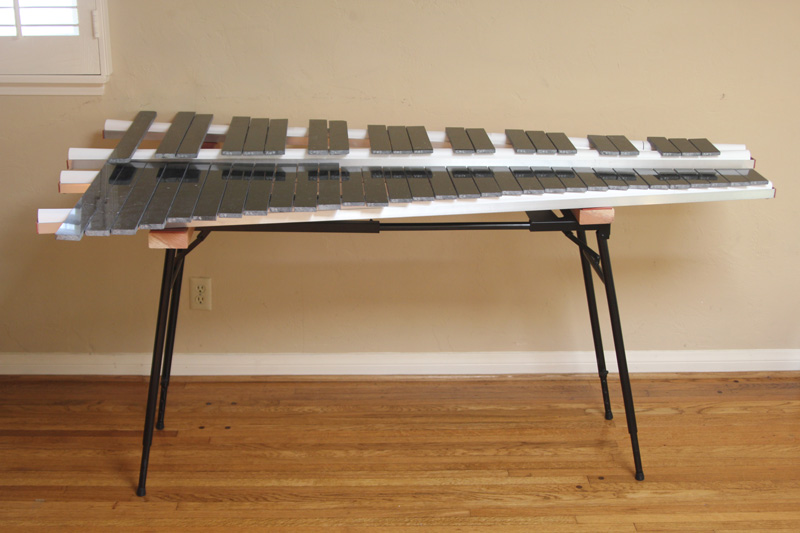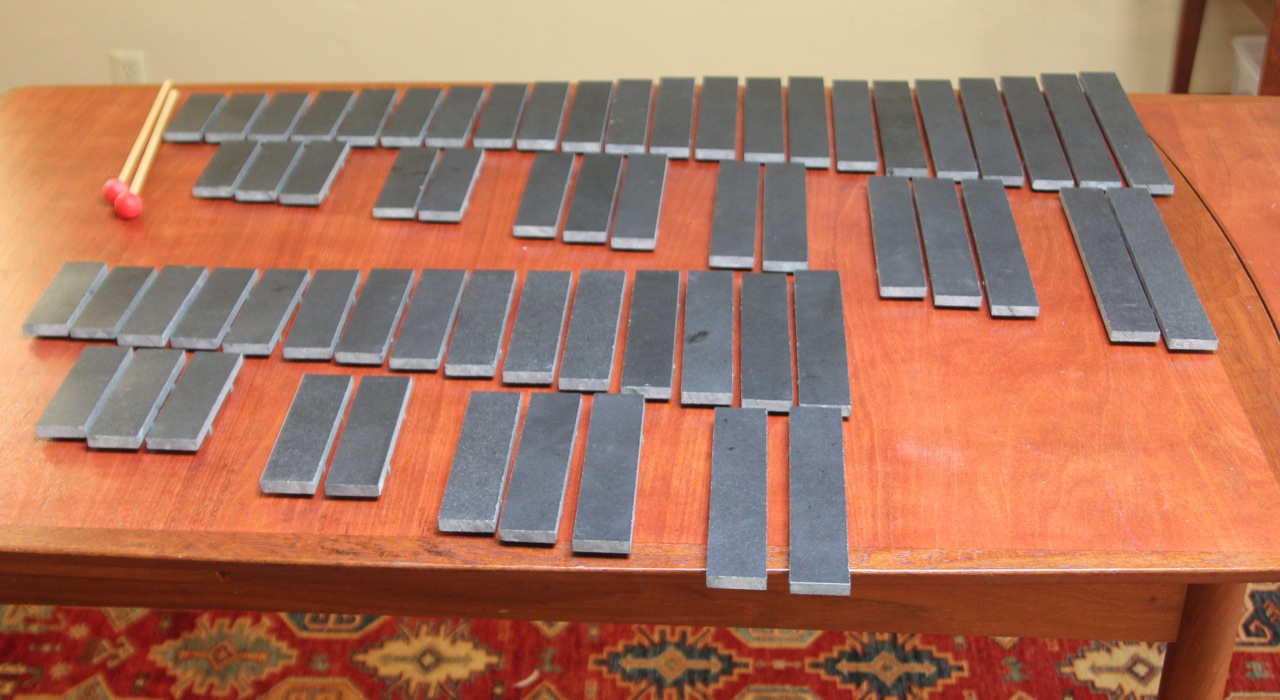Chwe
Lithophones

Our family started
making lithophones in the summer of 2011. A lithophone is
a keyboard percussion instrument, like a xylophone, in which the
bars are made out of stone. In the spring of 2013, we had
the honor of being asked by Daumas Percussion
to build a lithophone to be played by the Orchestre National de
Lyon on May 25, 2013, in their performance
of Unsuk
Chin's Concerto for Piano. To see video of these
lithophones being played, please click here.
The first lithophone we made (pictured
below) had a range of 4.3 octaves, going from A3 to C8, essentially
the top half of the piano. Details about its construction
are available here. We used
"Black Galaxy" granite for the bars, and mounted them on arches
of paper (card stock). The paper arches do a very nice job
of supporting the bars without deadening the sound, but they
tend to collapse over time, especially for the more heavy
bars. We keep this instrument in our home. The total
cost of materials was around $300.

We made the second
lithophone (pictured below) in the fall of 2012. This one
had a range of 2.5 octaves, from F5 to C8. This lithophone
was intended to be simple and "portable." We used "Absolute
Black" granite, which had a denser "grain" than "Black Galaxy" and
produces a more bell-like sound. We also used inexpensive stroboscopic
tuning software to tune the bars, which works much better
than the Korg
OT-12 we used to tune the first lithophone. We used
cork as "feet" for the bars (placed on the nodes of the bars), so
they can be played on a tabletop. The total cost of
materials was around $60–a 12 inch by 12 inch granite tile costs
around $10, and each square foot can be carved into around five
bars. We donated this instrument to the Santa Monica High
School choral program for their yearly fundraiser.

We made the third and
fourth lithophones (pictured below) in March 2013, for Daumas
Percussion. The third (numbered 2013.1) had a
range of three octaves, from C5 to C8, and the fourth (numbered
2013.2) had a range of two octaves, from C6 to C8. Video of
me playing these instruments (not very well) is available here. These
bars are tuned to the A=442 European standard (my earlier ones
were tuned to A=440). I used rubber foam (weatherstripping
material) for the "feet" of these bars. It took around
twelve granite tiles (12 inch by 12 inch) to make these
bars. Bars below F5 are longer than 12 inches long and thus
must be cut diagonally from a single tile.

I encourage you to try
making a lithophone! You can get all the materials and tools
at a store like Home Depot. The main tool is a tile saw,
which is not expensive (around $100) and not difficult to use
(make sure to use full safety gear, including a face mask,
respirator, and ear protection). Making
a lithophone is not more difficult than many home
improvement projects. You just need patience tuning the
bars, and stroboscopic tuning software helps immensely. In
my experience, it is possible to tune the bars to an accuracy of 2
cents,
where 100 cents = 1 half step. The bars must be tuned by
hand, because the thickness of the tile greatly influences the
pitch, and there can be significant variation in tile
thickness. I have used granite mainly, but many materials
are possible. For more information about lithophones, please
visit lithophones.com.
We were personally inspired by the band Sigur Ros playing a
lithophone in their movie Heima.
If you are interested in us making a lithophone for you, please
contact Michael Chwe at michael@chwe.net.



